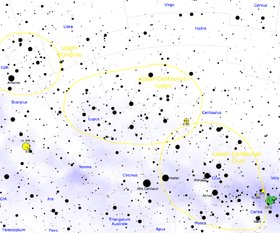Scorpius–Centaurus Association

The Scorpius–Centaurus Association (sometimes called Sco–Cen or Sco OB2) is the nearest OB association to the Sun. This stellar association is composed of three subgroups (Upper Scorpius, Upper Centaurus–Lupus, and Lower Centaurus–Crux), whose mean distances range from 380 to 470 light years.[1] Using improved Hipparcos data, Rizzuto and colleagues analysed nearby stars more closely, bringing the number of known members to 436. They doubt the need to add a subclassification because they found a more continuous spread of stars.[2]
The Sco–Cen subgroups range in age from 11 million years (Upper Scorpius)[3] to roughly 15 million years (Upper Centaurus–Lupus and Lower Centaurus–Crux). Many of the bright stars in the constellations Scorpius, Lupus, Centaurus, and Crux are members of the Sco–Cen association, including Antares (the most massive member of Upper Scorpius), and most of the stars in the Southern Cross.[4] Hundreds of stars have been identified as members of Sco-Cen, with masses ranging from roughly 15 solar masses (Antares) down to below the hydrogen-burning limit (i.e. brown dwarfs),[5] and the total stellar population in each of the three subgroups is probably of the order 1000–2000.[6] The Sco–Cen OB association appears to be the most pronounced part of a large complex of recent (<20 million years) and ongoing star-formation. The complex contains several star-forming molecular clouds in Sco–Cen's immediate vicinity—the Rho Oph, Pipe Nebula, Barnard 68, Chamaeleon, Lupus, Corona Australis, and Coalsack cloud complexes (all at distances of ~120-200 parsecs), and several less populous, young stellar groups on the periphery of Sco–Cen, including the ~3–5 million-year-old epsilon Cha group, ~7 million-year-old eta Chamaeleontis cluster (also called Mamajek 1), ~8 million-year-old TW Hydrae association, ~12 million-year-old Beta Pictoris moving group, and possibly the ~30–50 million-year-old IC 2602 open cluster.[4]
The stellar members of the Sco–Cen association have convergent proper motions of approximately 0.02–0.04 arcseconds per year, indicative that the stars have nearly parallel velocity vectors, moving at about 20 km/s with respect to the Sun. The dispersion of the velocities within the subgroups are only of order 1–2 km/s,[7] and the group is most likely gravitationally unbound. Several supernovae have exploded in Sco–Cen over the past 15 million years, leaving a network of expanding gas superbubbles around the group,[8] including the Loop I Bubble. To explain the presence of radioactive 60Fe in deep ocean ferromanganese crusts and in biogenic magnetite crystals within Pacific Ocean sediments[9] it has been hypothesized that a nearby supernova, possibly a member of Sco–Cen, exploded in the Sun's vicinity roughly 3 million years ago,[10] causing the Pliocene–Pleistocene boundary marine extinction;[11] however, the distance at which this supernova occurred (more than 100 parsec) is likely not to have contributed to this extinction through the mechanism of the so-called ultra-violet B (UV-B) catastrophe.[9][12]
References
- ↑ de Zeeuw, P.T.; Hoogerwerf, R.; de Bruijne, J.H.J.; Brown, A.G.A.; et al. (1999). "A Hipparcos Census of Nearby OB Associations". Astronomical Journal. 117 (1): 354–399. arXiv:astro-ph/9809227
 . Bibcode:1999AJ....117..354D. doi:10.1086/300682.
. Bibcode:1999AJ....117..354D. doi:10.1086/300682. - ↑ Rizzuto, Aaron; Ireland, Michael; Robertson, J. G. (October 2011), "Multidimensional Bayesian membership analysis of the Sco OB2 moving group", Monthly Notices of the Royal Astronomical Society, 416 (4): 3108–17, arXiv:1106.2857
 , Bibcode:2011MNRAS.416.3108R, doi:10.1111/j.1365-2966.2011.19256.x.
, Bibcode:2011MNRAS.416.3108R, doi:10.1111/j.1365-2966.2011.19256.x. - ↑ Mark J. Pecaut; Eric E. Mamajek & Eric J. Bubar (February 2012). "A Revised Age for Upper Scorpius and the Star Formation History among the F-type Members of the Scorpius-Centaurus OB Association". Astrophysical Journal. 746 (2): 154. arXiv:1112.1695
 . Bibcode:2012ApJ...746..154P. doi:10.1088/0004-637X/746/2/154.
. Bibcode:2012ApJ...746..154P. doi:10.1088/0004-637X/746/2/154. - 1 2 Preibisch, T.; Mamajek, E. (2009). "The Nearest OB Association: Scorpius-Centaurus (Sco OB2)". Handbook of Star-Forming Regions. 2: 0. arXiv:0809.0407
 . Bibcode:2008hsf2.book..235P.
. Bibcode:2008hsf2.book..235P. - ↑ Preibisch, T.; et al. (2002). "Exploring the Full Stellar Population of the Upper Scorpius OB Association". Astronomical Journal. 124 (1): 404–416. Bibcode:2002AJ....124..404P. doi:10.1086/341174.
- ↑ Mamajek, E.E.; Meyer, M.R. & Liebert, J. (2002). "Post-T Tauri Stars in the Nearest OB Association". Astronomical Journal. 124 (3): 1670–1694. arXiv:astro-ph/0205417
 . Bibcode:2002AJ....124.1670M. doi:10.1086/341952.
. Bibcode:2002AJ....124.1670M. doi:10.1086/341952. - ↑ Madsen, S.; et al. (2002). "Astrometric radial velocities. III. Hipparcos measurements of nearby star clusters and associations". Astronomy & Astrophysics. 381 (2): 446–463. arXiv:astro-ph/0110617
 . Bibcode:2002A&A...381..446M. doi:10.1051/0004-6361:20011458.
. Bibcode:2002A&A...381..446M. doi:10.1051/0004-6361:20011458. - ↑ de Geus, E.J. (1992). "Interaction of Stars and Interstellar Matter in Scorpio Centaurus". Astronomy & Astrophysics. 262: 258–270. Bibcode:1992A&A...262..258D.
- 1 2 Ludwig, Peter; et al. (2016). "Time-resolved 2-million-year-old supernova activity discovered in Earth's microfossil record". Proceedings of the National Academy of Sciences. 113 (33): 9232–9237. doi:10.1073/pnas.1601040113. ISSN 0027-8424.
- ↑ Fields, Brian D.; Hochmuth, Kathrin A.; Ellis, John (2005). "Deep-Ocean Crusts as Telescopes: Using Live Radioisotopes to Probe Supernova Nucleosynthesis". Astrophys. J. 621 (2): 902–07. arXiv:astro-ph/0410525
 . Bibcode:2005ApJ...621..902F. doi:10.1086/427797.
. Bibcode:2005ApJ...621..902F. doi:10.1086/427797. - ↑ Benítez, N.; Maíz-Apellániz, J.; Canelles M. (2005). "Evidence for nearby supernova explosions". Phys Rev Lett. 88 (8): 081101. arXiv:astro-ph/0201018
 . Bibcode:2002PhRvL..88h1101B. doi:10.1103/physrevlett.88.081101. PMID 11863949.
. Bibcode:2002PhRvL..88h1101B. doi:10.1103/physrevlett.88.081101. PMID 11863949. - ↑ Cockell, CS (1999). "Crises and extinction in the fossil record—A role for ultraviolet radiation?". Paleobiology. 25 (2): 212–225. doi:10.1017/S0094837300026518.